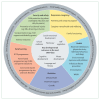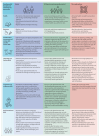The next 1000 days: building on early investments for the health and development of young children
- PMID: 39571589
- PMCID: PMC7617681
- DOI: 10.1016/S0140-6736(24)01389-8
The next 1000 days: building on early investments for the health and development of young children
Abstract
Following the first 1000 days of life that span from conception to two years of age, the next 1000 days of a child's life from 2-5 years of age offer a window of opportunity to promote nurturing and caring environments, establish healthy behaviours, and build on early gains to sustain or improve trajectories of healthy development. This Series paper, the first of a two-paper Series on early childhood development and the next 1000 days, focuses on the transition to the next 1000 days of the life course, describes why this developmental period matters, identifies the environments of care, risks, and protective factors that shape children's development, estimates the number of children who receive adequate nurturing care, and examines whether current interventions are meeting children's needs. Paper 2 focuses on the cost of inaction and the implications of not investing in the next 1000 days. In low-income and middle-income countries (LMICs), only 62 million children aged 3 and 4 years (25·4%) currently receive adequate nurturing care during the next 1000 days, leaving 181·9 million children exposed to risks that jeopardise their healthy development. Inputs across nurturing care dimensions of health, nutrition, protection, responsive care, and learning vary substantially across countries. In LMICs, although 86·2% of children have a healthy weight in this period, less than one in three children have access to developmental stimulation or are protected from physical punishment, and only 38·8% have access to early childhood care and education services. Intervention research in LMICs in the next 1000 days is scarce. The continuity of developmentally appropriate nurturing care, coordination across health, education, and protection sectors, and the implementation of interventions to support caregivers and improve the quality of education and care remain top priorities in this period. These sectors play key roles in promoting quality early care and education for this age group, which will help maximise developmental potential and opportunities of children globally and help progress towards the achievement of the Sustainable Development Goals.
Copyright © 2024 Elsevier Ltd. All rights reserved, including those for text and data mining, AI training, and similar technologies.
Conflict of interest statement
Declaration of interests CED's work is supported by the South African Medical Research Council. SK's work was supported by a postdoctoral research grant from Kone Foundation. JO's contribution was supported by a Jacobs Foundation Advanced Research Fellowship. JF is supported by the Finkel Professorial Fellowship, which is funded by the Finkel Family Foundation. All other authors declare no competing interests.
Figures






References
-
- Walker SP, Wachs TD, Gardner JM, et al. Child development: risk factors for adverse outcomes in developing countries. Lancet. 2007;369:145–57. - PubMed
-
- Engle PL, Black MM, Behrman JR, et al. Strategies to avoid the loss of developmental potential in more than 200 million children in the developing world. Lancet. 2007;369:229–42. - PubMed
-
- Walker SP, Wachs TD, Grantham-McGregor S, et al. Inequality in early childhood: risk and protective factors for early child development. Lancet. 2011;378:1325–38. - PubMed
-
- Engle PL, Fernald LC, Alderman H, et al. Strategies for reducing inequalities and improving developmental outcomes for young children in low-income and middle-income countries. Lancet. 2011;378:1339–53. - PubMed
Publication types
MeSH terms
Grants and funding
LinkOut - more resources
Full Text Sources
Medical

